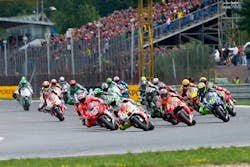Czech Republic MotoGP debrief with Shinji Aoki
Repsol Honda’s Marc Marquez extended his winning streak to four races after the rookie beat teammate Dani Pedrosa in an enthralling contest at Brno last Sunday.
The Repsol Honda duo finished ahead of Yamaha Factory Racing’s Jorge Lorenzo who challenged the pair all the way to the end of the twenty-two lap contest.
Conditions at Brno on race day were cool, with a peak track temperature of 23°C recorded during the race – a massive thirty degrees cooler than was recorded during the previous race at Indianapolis. The cool temperatures resulted in all riders selecting softer rear slick options for the race, while all but three of the twenty-five riders selecting the hard compound front slick tyre.
Q&A with Shinji Aoki – Manager, Bridgestone Motorsport Tyre Development Department
Track temperatures on race day were ten degrees cooler than in Free Practice 4 and Qualifying. Did this have any effect on tyre performance?
“The lower track temperatures on Sunday didn’t have any great effect on tyre performance; rather it influenced tyre choice, especially for the rear tyre. The warmest temperatures we experienced were on Friday afternoon when some riders tried the hard compound rear slick, and the rider feedback and lap times of this option were quite good so we assumed this would be an attractive race option. However, track temperatures for the race were around fifteen degrees cooler than Friday which put the hard compound rear tyre out of its working range. The cooler temperatures were no problem for the softer rear slick options as a new race lap record was set and the overall race time was the quickest ever recorded at the Brno circuit.”
The cooler weather prevented any riders selecting harder rear slick options for the race, but the harder front slick was by far the most popular choice for the race. Can you explain why this front option was chosen in what were quite cool temperatures?
“Brno features many downhill braking zones and sweeping corners which demand a lot of stability from the front-end of the motorcycle and the harder front slick does offer more stability than the softer option. The warm-up performance and edge grip of the soft compound front tyre is a bit better than the hard option, but most riders felt they could make better and more consistent lap times using the hard front slick. The soft compound front slick was mainly used in morning sessions when riders were assessing track conditions, but over a race distance most riders felt they hard front slick would yield the better performance, hence it being so popular on race day.”
Bridgestone planned on bringing a new hard compound rear tyre to Brno, but changed the allocation before the race to include the existing hard compound rear slick. Why did this change in allocation occur?
“Our decision to introduce the new hard compound rear tyre at Brno was based on the positive feedback we had from riders in tests earlier this year. This new compound worked quite well at circuits like Montmeló in high temperatures, but following a recent Yamaha test at Brno, the new hard compound didn’t seem to offer an advantage over the softer specification even in high temperatures at the Brno circuit. As a result, we consulted with the teams and it was agreed that we would supply a different hard option rear tyre using the soft compound on the left shoulder and the current hard compound on the right shoulder. I believe this was the right decision as when track temperatures were higher at Brno during the race weekend this current hard tyre was working well. The new hard compound will form part of our future tyre allocation, however we will test it further to find out which circuits it is best suited to before deciding where we will supply this option.”
